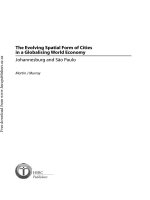The Art of Building in the Classical World
Bạn đang xem bản rút gọn của tài liệu. Xem và tải ngay bản đầy đủ của tài liệu tại đây (5.32 MB, 263 trang )
This page intentionally left blank
The Art of Building in the Classical World
This book examines the application of drawing in the creation of classical architec-
ture, exploring how the tools and techniques of drawing developed for architecture
subsequently shaped theories of vision and representations of the universe in sci-
ence and philosophy. Building on recent scholarship that examines and reconstructs
the design process of classical architecture, John R. Senseney focuses on technical
drawing in the building trade as a model for the expression of visual order, showing
that the techniques of ancient Greek drawing actively determined concepts about
the world. He argues that the uniquely Greek innovations of graphic construction
determined principles that shaped the massing, special qualities, and refinements of
buildings and the manner in which order itself was envisioned.
John R. Senseney is Assistant Professor of the History of Ancient Architecture
in the School of Architecture at the University of Illinois at Urbana–Champaign.
A historian of ancient Greek and Roman art and architecture, his current and
forthcoming articles and chapters appear in Hesperia,theJournal of the Society
of Architectural Historians,theInternational Journal of the Book, The Blackwell
Companion to Roman Architecture (edited by Roger Ulrich and Caroline Quenemoen),
and Sacred Landscapes in Anatolia and Neighboring Regions (edited by Charles Gates,
Jacques Morin, and Thomas Zimmermann).
᪉᪉᪉᪉
The Art of Building in the
Classical World
Vision, Craftsmanship, and
Linear Perspective in Greek and
Roman Architecture
John R. Senseney
University of Illinois at Urbana–Champaign
cambridge university press
Cambridge, New York, Melbourne, Madrid, Cape Town,
Singapore, S
˜
ao Paulo, Delhi, Tokyo, Mexico City
Cambridge University Press
32 Avenue of the Americas, New York, NY 10013-2473, USA
www.cambridge.org
Information on this title: www.cambridge.org/9781107002357
C
John R. Senseney 2011
This publication is in copyright. Subject to statutory exception
and to the provisions of relevant collective licensing agreements,
no reproduction of any part may take place without the written
permission of Cambridge University Press.
First published 2011
Printed in the United States of America
A catalog record for this publication is available from the British Library.
Library of Congress Cataloging in Publication data
Senseney, John R. (John Robert), 1969–
The Art of Building in the Classical World: Vision, Craftsmanship, and Linear
Perspective in Greek and Roman Architecture / John R. Senseney.
p. cm.
Includes bibliographical references and index.
ISBN 978-1-107-00235-7
1. Architectural design. 2. Architectural drawing. 3. Architecture, Classical. I. Title.
NA2750.S45 2011
722
.8–dc22 2010049728
ISBN 978-1-107-00235-7 Hardback
Cambridge University Press has no responsibility for the persistence or accuracy of URLs
for external or third-party Internet Web sites referred to in this publication and does not
guarantee that any content on such Web sites is, or will remain, accurate or appropriate.
᪉᪉᪉᪉
To Megan, with much of a muchness
᪉᪉᪉᪉
CONTENTS
List of Figures page ix
Preface xi
Note on Dates and Translations xiii
Abbreviations xv
Introduction: Challenges of Analysis and
Interpretation
1
1 The Ideas of Architecture
26
2 Vision and Spatial Representation
60
3 The Genesis of Scale Drawing and Linear Perspective
104
4 Architectural Vision
142
Excursus: Envisioning Cosmic Mechanism in Plato and Vitruvius 175
Appendix A Analysis of the Dimensions of the Blueprint for Entasis at Didyma 189
Appendix B Analysis of the Hypothetical Working Drawing for Platform
Curvature at Segesta 191
Appendix C Analysis of the Hypothetical Working Drawing for Platform
Curvature in the Parthenon 192
Notes 195
References 227
Index 241
᪉
vii
᪉᪉᪉᪉
LIST OF FIGURES
1. Pantheon, Rome. a.d. 120s, 2
2. Classical Parthenon, Athens.
447–438 b.c., 3
3. Myron of Athens (fifth century b.c.).
Diskobolos (Lancellotti Discobolus), 5
4. Myron of Athens (fifth century b.c.).
Diskobolos (Lancellotti Discobolus), 6
5. Horse and jockey. Hellenistic,
ca. 150–125 b.c., 7
6. Sleeping hermaphrodite. Antonine copy
(a.d. 138–192) of a Hellenistic original of
the second century b.c., 7
7. Hellenistic Didymaion, 12
8. Hellenistic Didymaion, 13
9. Hellenistic Didymaion, 13
10. Hellenistic Didymaion, 15
11. Leonardo da Vinci (1452–1519). The
“Vitruvian Man,” 20
12. Theater of Dionysos, Athens, 21
13. Forum of Caesar, Rome, 24
14. Whole-number ratios used in Greek temple
buildings of the Classical period, 27
15. Temple of Juno Lacinia, Agrigento, 28
16. Temple of Concordia, Agrigento, 29
17. Temple at Segesta, 30
18. Hephaisteion, Athens, 30
19. Hephaisteion, Athens, 31
20. Parthenon, Athens, 32
21. Parthenon, Athens, 33
22. Anta Building, Didyma and East Building,
Didyma, 35
23. Hermogenes (third and second centuries
b.c.). Temple of Artemis Leukophryne at
Magnesia-on-the-Maeander, 37
24. Archaic Parthenon, Athens. Modified from
M. Korres, 39
25. Akropolis, Athens, 40
26. Schematic comparison of typical plans of
Doric hexastyle and Ionic octastyle temples
with the Parthenon, 41
27. Parthenon, Athens, 42
28. Parthenon, Athens, 43
29. Temple of Athena, Paestum (ancient Greek
Poseidonia), 46
30. The symbol of the tetraktys, 46
31. Temple A, Asklepieion, Kos, 47
32. Temple A, Asklepieion, Kos, 48
33. Hellenistic Didymaion, 49
34. Diagram for Euclid’s proof of a geocentric
universe, 61
35. The zodiac as a circular construction with
twelve equal sectors for the signs, 66
36. The revolving cosmos according to the
model of Eudoxos, 67
37. The zodiac as a twenty-four-part
construction, 69
38. Tholos on the Marmaria terrace, Sanctuary
of Athena Pronaia, Delphi, 70
39. Tholos at the Asklepieion, Epidauros, 71
40. Round Temple, Rome, ca. 100 b.c., 72
41. The Latin Theater as described by
Vitruvius, 73
᪉
ix
List of Figures
42. The six-petal rosette, 76
43. Diagram of Aristoxenos (fourth century
b.c.) for the placements of sounding vessels
in the theater, 77
44. Circuits of the revolutions of the moon,
sun, and planets through the zodiac, 78
45. Markets of Trajan, Rome, 79
46. Theater, Asklepieion, Epidauros, 80
47. Theater, Asklepieion, Epidauros, 81
48. Theater, Akropolis, Pergamon, 81
49. The Greek theater, according to
Vitruvius, 82
50. Lower theater at Knidos. Modified from
I.C. Love, 83
51. Diagrams of Greek theaters with their
geometric underpinnings, 84
52. Diagrams of Greek theaters with their
geometric underpinnings, 85
53. Theater at Priene, 87
54. Hypothetical Greek protractor or “curved
ruler” indicating angular divisions of
15 degrees, 91
55. Pnyx, Athens, phase III, 96
56. Pnyx, Athens, phase III, 97
57. Graphic form of the analemma as described
by Vitruvius, 101
58. Hellenistic Didymaion, 105
59. Hellenistic Didymaion, 105
60. Hellenistic Didymaion, 107
61. Temple at Segesta, 109
62. Hellenistic Didymaion. Modified from
L. Haselberger, 111
63. Parthenon, Athens, 115
64. Proposed graphic constructions for
platform curvature on the northern flanks
of the temple at Segesta and the
Parthenon, 117
65. Archaic Didymaion. Restored capital, 118
66. Hellenistic Didymaion, 119
67. Stoa, Agora, Kos. Unfinished Ionic column
drum preserving the radial construction for
the fluting of its Ionic columns, 120
68. Artemision, Sardis. Detail of column,
121
69. Hellenistic Didymaion, 122
70. Hellenistic Didymaion, 123
71. Proposed sequence for fluting drums at the
Hellenistic Didymaion according to
analysis of blueprint, 124
72. “Rosette-based” method for determining
fluting on a blueprint like that at
Didyma, 125
73. Hellenistic Didymaion. Pit on surface of the
north adyton wall of the Didymaion, 126
74. Hellenistic Didymaion. Blueprint for
column fluting, 126
75. Hypothetical methods of producing twenty
equal divisions of circumference for Doric
fluting, 127
76. Hypothetical methods of fluting columns
using a protractor, 131
77. The zodiac as a circular construction with
twelve equal sectors for the signs; the
Greek theater according to Vitruvius, 133
78. Artemision and agora,
Magnesia-on-the-Maeander, 140
79. Human form defined by sample modules,
proportions, and geometry, as described by
Vitruvius, 145
80. Temple of Athena Polias, Priene. Restored
drawing of a cornice and pediment incised
into a block built into the temple, 154
81. Temple of Athena Polias at Priene by
Pytheos and Temple of Artemis
Leukophryne at
Magnesia-on-the-Maeander by
Hermogenes, 155
82. Temple of Athena Polias, Priene, 157
83. Temple of Dionysos at Teos, 159
84. Asklepieion, Kos, 162
85. Upper Terrace with Temple A,
Asklepieion, Kos, 163
86. Temple A, Asklepieion, Kos, 163
87. Sanctuary of Juno, Gabii, 164
88. Temple of Juno, Gabii, ca. 160 b.c., 165
89. Temple of Juno, Gabii, 166
90. Sanctuary of Aphrodite, Kos, 167
91. Severan Marble Plan fragments showing
the Porticus Octaviae (Porticus Metelli,
renamed and rebuilt under Augustus),
Rome, overlaying modern urban
features, 168
92. Porticus Metelli (later Porticus Octaviae),
Rome, 169
93. Forum of Trajan, Rome, 171
94. Octagon of Nero’s Golden House on the
Esquiline Hill in Rome, 173
95. Pantheon, Rome, 174
x
᪉
᪉᪉᪉᪉
PREFACE
This book examines the importance of Greek building and thought for the
creation of architecture as Vitruvius understood it in a Roman context. In
focusing on the central role of Greek practices of scale drawing and linear
perspective, it considers the influence that Roman architecture drew on from
Greek architects and concepts of craftsmanship. More than this, however, I
explore the impact of the instruments and techniques of Greek architects on
the classical understanding of the forms and mechanisms of nature and how
the eye perceives them. Rather than demonstrating how classical architecture
merely reflects the features of its larger cultural context, I try to show how the
practices of Greek architects actively determined concepts about the world. In
addition to classicists and historians of art and architecture, therefore, this book
addresses readers interested in the history of philosophy and science, as well as
architects who draw inspiration from the classical world.
In acknowledging only a small share of those directly involved with the
realization of this work, I want to first thank my mentor, Fikret K. Yeg
¨
ul, who,
in addition to training me in ancient art and architecture, read this book’s
manuscript in its entirety. His expertise allowed for the comments, criticisms,
and insights necessary to elevate it above the artlessness of its first draft. Credit
for the merits of this project must go to Beatrice Rehl, Publishing Director
of Humanities and Social Sciences at Cambridge University Press. Beatrice’s
editorial assistant, Amanda Smith, provided invaluable help in the realization
of this book. My wife, Megan Finn Senseney, read and edited later drafts of
the manuscript, enhancing it with her gift for language and her command of
sources as a real information scientist. I would also like to express gratitude to the
particularly thoughtful anonymous reviewers of my manuscript, who provided
encouragement and much needed perspectives on both details and larger issues.
Architects Sarang Gokhale and Erin Haglund offered excellent assistance with
my line drawings that illustrate many of the arguments of this book.
᪉
xi
Preface
At various stages, the ideas of this book benefited from conversations with
several classicists and historians of art and architecture. James and Christina
Dengate were always generous with their enthusiasm, feedback, and sharing
of sources. Diane Favro challenged my ideas with incisive questions. Erich
Gruen took the time to meet with me and offer his ideas on the Hellenistic and
Roman historical contexts of my research on ancient architecture. Richard Mohr
offered invaluable feedback on my interest in Plato. Robin Rhodes generously
discussed the details of my research and invited me to join his panel exploring the
subject of scale in Greek architecture. David Sansone gave important feedback
on my interest in Aristophanes. Phil Sapirstein provided enlightening thoughts
and questions about the technology of building and design, particularly in
the Archaic period. Both in person and via email, Andrew Stewart asked me
penetrating questions about my developing research in Greek architectural
drawing, which resulted in several of the paths I later took in this book. Phil
Stinson gave me his thoughts and encouragement on a variety of topics. I have
also benefited from my colleagues researching the topic of historical architectural
drawing in later periods, including Robert Bork, Anthony Gerbino, Raffaela
Fabbiani Giannetto, Ann Huppert, and Heather Hyde Minor. In addition to
Heather Hyde Minor, this study simply would not have been possible without
the incredible support of my colleagues Dianne Harris and Areli Marina. Finally,
the ideas and approaches in the book build on a foundation in art history shaped
by my amazing teachers, C. Edson Armi and Larry Ayres. Any mistakes of fact
or questionable interpretations in the final work result from my own divergence
from the helpful suggestions of these excellent scholars.
Concepts also developed from the help of several friends and family mem-
bers, including Jonathan Banks, Brent Capriotti, Heidi Capriotti, Barbara Cohen,
Lawrence Hamlin, Dan Korman, Geza Kotha, Paolo Maddaloni, Rick Merca-
toris, Madhu Parthasarathy, Donna Senseney, Megan Finn Senseney, Debbie
Senseney-Kotha, Kevin Serra, Leonore Smith, Smitha Vishveshwara, and many
others.
Lastly, the following awards provided indispensable support for the research
and writing of this book: A William and Flora Hewlett International Research
Travel Grant; funding for travel, research assistantships, a partial release from
teaching, and image reproduction rights from the Campus Research Board of
the University of Illinois at Urbana–Champaign; travel funding from the Laing
Endowment of the School of Architecture at the University of Illinois at Urbana–
Champaign; and travel funding from two separate Creative Research Awards of
the College of Fine and Applied Arts of the University of Illinois at Urbana–
Champaign.
John R. Senseney
Heraklion, May 2010
xii
᪉
᪉᪉᪉᪉
NOTE ON DATES AND TRANSLATIONS
All dates are b.c. unless specified as a.d. or given in obvious post-antique
contexts like the Renaissance. Classical with a capital “C” indicates the Classical
period of ancient Greece specifically (479–323 b.c.), whereas classical with a
lowercase “c” more generally describes Greek and Roman antiquity.
An exact or even relative chronology of the works of Plato (ca. 427–347 b.c.)
is perhaps impossible to establish with any certainty. For the purposes of the
present study, it will suffice to recognize Plato as a writer of the Late Classical
period in the early to mid-fourth century b.c., and to follow the unquestionable
chronological order of the Republic before the Timaeus.
Unless otherwise indicated, quotations from primary sources are given in the
author’s translation.
᪉
xiii
᪉᪉᪉᪉
ABBREVIATIONS
Abbreviations not specified in this section follow the standard abbreviations set forth
in the American Journal of Archaeology.
Bauplanung Deutsches Arch
¨
aologisches Institut, ed. (no date). Bauplanung und
Bautheorie der Antike. Bericht
¨
uber ein Kolloquium veranstaltet vom
Architekturreferat des Deutschen Arch
¨
aologischen Instituts (DAI) mit
Unterst
¨
utzung der Stiftung Volkswagenwerk in Berlin vom 16.11 bis
18.11.1983. Berlin.
Gabii Almagro-Gorbea, M., ed. 1982. El Santuario del Juno en Gabii.
Biblioteca Italica 17. Rome.
Hermogenes Hoepfner, W., ed. 1990. Hermogenes und die hochhellenistiche
Architektur. Internationales Kolloquium in Berlin vom 28. bis 29. Juli
1988 im Rahmen des XIII. Internationalen Kongresses f
¨
ur Klassische
Arch
¨
aologie veranstaltet vom Architekturreferat des DAI in
Zusammenarbeit mit dem Seminar f
¨
ur Klassische Arch
¨
aologie der
Freien Universit
¨
at Berlin. Mainz am Rhein.
K
¨
ustlerlexikon Vollkommer, R., ed. 2001. K
¨
ustlerlexikon der Antike. Munich and
Leipzig.
Parthenon Neils, J., ed. 2005. The Parthenon: From Antiquity to the Present.
Cambridge.
Refinements Haselberger, L. 1999. Appearance and Essence. Refinements of
Classical Architecture: Curvature. Proceedings of the Second Williams
Symposium on Classical Architecture held at the University of
Pennsylvania, Philadelphia, April 2–4, 1993. Philadelphia.
Vitruvius Geertman, H. and J.J. de Jong, eds. 1989. Munus non ingratum:
Proceedings of the International Symposium on Vitruvius’ De
architectura and Hellenistic and Republican Architecture = BABesch,
supp. 2. Leiden.
᪉
xv
᪉᪉᪉᪉
INTRODUCTION: CHALLENGES OF
ANALYSIS AND INTERPRETATION
When Renaissance architects like Bramante or Alberti executed or wrote about
linear perspective and scale architectural drawings, they engaged in practices
and discourses that were already well established by the time Vitruvius picked
up his pen near the end of the first millennium b.c.
1
In addition to what Vitruvius
tells us about the subject, there are other Roman references to scale drawings
used in architectural planning,
2
as well as a few surviving examples that can
hardly attest to the frequency with which such drawings surely must have
been made.
3
More than just a fact of the design process, the application of
geometry in scale drawings during the Imperial era in particular may have
engendered the very aesthetic based on the curve and polygon that characterizes
Roman vaulted buildings perhaps as best appreciated today in the Pantheon
(Figure 1).
This observation, which is far from new, underscores the formative role of
reduced-scale drawing not only in the creation of buildings, but also in the
guiding approaches to form that underlie their production.
4
In a straightfor-
ward emphasis on technical determinism, one may view the fluid, plastic poten-
tial of Roman concrete as the primary impetus that transcended the prismatic
forms determined by traditional Greek construction with rectilinear blocks.
5
Yet keeping in mind the additional importance of the curvilinear, radial, and
polygonal qualities of classical scale drawings, one may perhaps better under-
stand Roman concrete as the material exploited to reflect in three dimensions the
forms first explored in ichnography (the art of ground plans), elevation draw-
ing, and linear perspective.
6
Acknowlement of this generative aspect of ancient
drawings emphasizes their function as models rather than mere architectural
representations.
7
᪉
1
The Art of Building in the Classical World
1 Pantheon, Rome. a.d. 120s. Plan of level III showing radial pattern of intrados. Drawing
author, adapted from B.M. Boyle, D. Scutt, R. Larason Guthrie, and D. Thorbeck, in
MacDonald 1982: Plate 103.
Of course, the idea that scale drawing precedes building should hardly sound
revolutionary. At least until recently, architectural students commonly learned
to conceive of buildings in terms of parti, or the geometrical underpinnings that
inform one’s composition as a whole and the interrelationships of its parts. This
2
᪉
Introduction: Challenges of Analysis and Interpretation
2 Classical Parthenon, Athens. 447–438 b.c. Ground Plan. Drawing author, modified from
M. Korres, in Korres 1994: Figure 2.
approach to design results in a sequential process that directly links the final
built form with the first moments of drawing at small scale.
8
The modern habituation with scale drawings may emerge from not only the
ways that architects design, but also from institutionalized ways of thinking
about buildings. After the initial publication of Sir Banister Fletcher’s A History
of Architecture on the Comparative Method in 1896,
9
historians of art and archi-
tecture came to largely understand the works of all periods through illustrations
that compare buildings to one another, often at a strictly typological level. In
turn, this kind of representation often serves to form part of the modern image
of a given historical building. Relatively few introductory-level students are
fortunate enough to experience the Parthenon for the first time when walking
in the open air of the Athenian Akropolis rather than in a textbook or dark
lecture hall where they view the temple by way of a small-scale set of black
lines (Figure 2). This graphic illustration of a ground plan then becomes a part of
a new generation’s image of the Parthenon and comes to represent how architec-
tural space is organized in ways that compare or contrast the supposed drawing
board of Iktinos with that of Brunelleschi or Mies or Zaha Hadid.
10
In this way,
drawing itself becomes an exceedingly familiar, culturally neutral act with a
universal application in buildings across time that express vastly different forms
and purposes.
In focusing on the gap that separates the instruments, methods, and appli-
cations of technical drawing in classical and modern architecture, the present
study explores how craftsmanship conditioned vision in the classical world. As
I argue, the shared habits of drawing in the art of building and the sciences
became central to the entity that, in Roman times, would receive the designation
᪉
3
The Art of Building in the Classical World
of “architecture” passed down to western traditions of building. The shaping
of order according the tools and techniques of craftsmanship directly impacted
how Greeks saw the structures and mechanisms of nature, as well as the under-
standing of vision itself as articulated in philosophy and optical theory. Against
this background, I present the Greek invention of linear perspective as reflec-
tive of existing procedures of drawing and influential for the heightened role of
scale drawing in the organization of architectural space beginning in the Clas-
sical period (479–323 b.c.). In this exploration, I approach the Greek theatron –
the “place for seeing” – as the earliest space expressly designed to shape vision,
enhancing the rituals of spectacle associated with Greek practices of seeing that
served the metaphor for “theory” itself as a new way of explaining the universe
in abstract and internally coherent ways. The resulting “architectural vision”
was to define how sacred and urban space was planned by way of ichnography,
itself born of linear perspective in Greek painting. This book thereby considers
the impact of the art of building on classical constructions and perceptions of
the world.
With good reason, the centrality of scale graphic representations as an art his-
torical focus in the manner of this book has been challenged in recent decades.
Kevin Lynch’s seminal sociological study of the ways in which westerners
understand their cities as collectives of landmarks, nodes, paths, districts, and
edges came to suggest an alternative model of analysis according to cognition at
an experiential level.
11
For the classical material, studies of urban architecture
have emphasized the integrated nature of Roman cities sensorily experienced
at eye level by the ambulating subject who responded to partial, oblique, and
gradually unfolding vistas.
12
Researchers have awoken an interest in the inter-
action of Roman viewers with the everyday experience of their cities through
sequential, three-dimensional “armatures” comprised of piecemeal assemblages
of structures over time rather than just urban plans or individual buildings
studied as isolated ground plans, elevation drawings, and sections that do not
correlate to how ancient buildings were actually seen. This methodology pro-
vides a salutary dose of imagination needed to restore a humanizing sense of
life, motion, and even emotion to how buildings worked in antiquity.
13
In this
way, a new historical narrative has relocated classical architecture in a kind of
real space that allows one to grasp its former potential to be intuited temporally
through the senses of the people who, driven by desire and necessity, lived and
moved within it.
As opposed to buildings, complexes, and cities, sculptures need not involve
a similar degree of changing perspective in motion on the part of the spectator.
As a textbook example of a fixed frontal perspective, even a dynamic sculpture
in the round like a Roman copy of Myron’s Diskobolos of the mid-fifth century
(Figures 3–4) disappoints rather than rewards the alternative perspectives of
a wandering viewer’s change of position, revealing a flatness and imbalance
4
᪉
Introduction: Challenges of Analysis and Interpretation
3 Myron of Athens (fifth century b.c.). Diskobolos (Lancellotti Discobolus). Roman copy
of Myron’s bronze original of ca. 460–450 b.c. Frontal view. Marble. Museo Nazionale
Romano (Palazzo Massimo alle Terme), Rome, Italy. Vanni/Art Resource, NY.
from the side that does little to break beyond even the static pose of an Archaic
kouros.
14
The unfolding, processual element found in classical architecture gains
emphasis when one confronts sculpture of the Hellenistic period in particu-
lar. A defining feature of Hellenistic art is the extension of dynamism inherent
in the work itself to the viewer’s interaction with the work. As seen in the
bronze horse and jockey pulled from an ancient shipwreck off Cape Artemision,
this quality transcends the principal view normally presented in published pho-
tographs (Figure 5).
15
The boy turns his glance toward an invisible opponent
with whom he seems to run neck-and-neck toward a “photo finish,” his horse
dedicating every muscle, fiber, and vein to the momentum and energy of the
final push. In terms of the height of its original placement and its accessibility,
᪉
5
The Art of Building in the Classical World
4 Myron of Athens (fifth century b.c.). Diskobolos (Lancellotti Discobolus). Roman copy
of Myron’s bronze original of ca. 460–450 b.c. Lateral view. Marble. Museo Nazionale
Romano (Palazzo Massimo alle Terme), Rome, Italy. Vanni/Art Resource, NY.
one cannot know how this work related to the perspective of ancient viewers,
but it seems unlikely to have differed significantly from its current display in the
National Archaeological Museum in Athens. Pulled in by curiosity, the engaged
spectator may find himself drawn to a frontal view where the full impact of
the horse’s velocity may be felt at an adrenaline-releasing, and indeed per-
sonally endangering, intensity.
16
The tension between one’s bodily reaction –
the impulse to freeze or jump out of the way – and the mind’s realization that
this is merely sculpture internalizes the spectator’s experience, breaking down
the space that otherwise separates the viewer from the work in the manner
of the Diskobolos, for example.
Perhaps one of the boldest Hellenistic expressions of vision in motion centers
on Roman copies representing a figure that is anything but dynamic (Figure 6).
Enticed by the erotic qualities of the sleeping figure, the unfolding experience
6
᪉
Introduction: Challenges of Analysis and Interpretation
5 Horse and jockey. Hellenistic, ca. 150–125 b.c. Lateral view. Found off Cape Artemision,
Greece. Bronze. Parts of horse’s barrel restored, tail modern replacement. National
Archaeological Museum, Athens, Greece. Vanni/Art Resource, NY.
of seeing results in perplexity and astonishment at a hermaphrodite’s male
genitalia, “a typically Hellenistic theatrical surprise.”
17
As described here, the
gradual, spatial, and temporal qualities of classical vision shows a kinship in the
differing media of sculpture and architecture that appears to come into being in
the Hellenistic period.
6 Sleeping hermaphrodite. Antonine copy (a.d. 138–192) of a Hellenistic original of
the second century b.c. View of backside. Marble. Museo Nazionale Romano (Palazzo
Massimo alle Terme), Rome, Italy. Vanni/Art Resource, NY.
᪉
7









